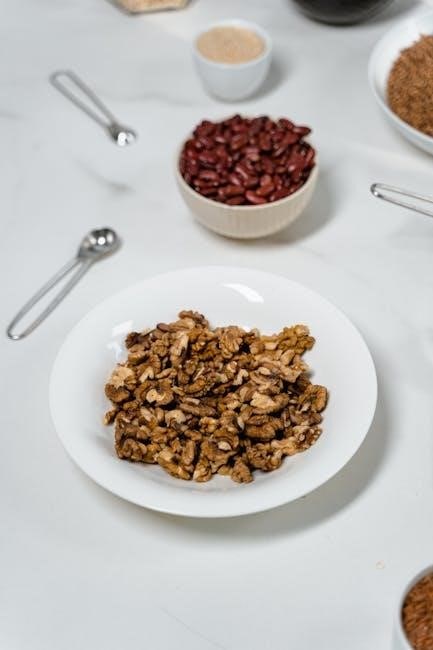
The Fasting Mimicking Diet (FMD) is a 5-day, plant-based eating plan designed to mimic fasting’s benefits, promoting cellular renewal and metabolic health without full fasting.
Developed by Dr. Valter Longo, FMD restricts calories and nutrients to trigger fasting-like responses, supporting weight loss, insulin sensitivity, and overall well-being in a structured, science-backed approach.
What is the Fasting Mimicking Diet?

The Fasting Mimicking Diet (FMD) is a 5-day, plant-based program designed to mimic the effects of fasting while allowing some food intake. Created by Dr. Valter Longo, it restricts calories and nutrients to trigger the body’s fasting response, promoting cellular renewal and improved metabolic health. The structured meal plan ensures essential nutrients are provided despite the low caloric intake, supporting overall well-being. This approach minimizes the challenges of traditional fasting, offering a sustainable way to achieve health benefits while maintaining nutritional balance. The FMD is a scientifically backed method to experience fasting’s advantages without complete food deprivation.
Benefits of the Fasting Mimicking Diet
The Fasting Mimicking Diet (FMD) offers numerous health benefits, including weight loss, improved insulin sensitivity, and enhanced cellular renewal. It promotes autophagy, a natural process where the body removes damaged cells, supporting overall rejuvenation. By mimicking fasting, the FMD can lower biological age, improve metabolic health, and reduce inflammation. Additionally, it helps maintain healthy blood sugar levels and may delay tumor progression. The structured meal plan ensures essential nutrients are provided, making it a sustainable and effective approach to achieving fasting-like benefits without complete food deprivation. These benefits contribute to improved longevity and anti-aging effects, making the FMD a popular choice for those seeking a science-backed path to better health.
How the Fasting Mimicking Diet Differs from Traditional Fasting
The Fasting Mimicking Diet (FMD) differs from traditional fasting by allowing the consumption of food while still inducing fasting-like effects. Unlike complete fasting, FMD involves eating plant-based, calorie-restricted meals designed to mimic fasting’s benefits. It limits protein, carbohydrates, and calories but provides essential nutrients, making it safer and more sustainable. Traditional fasting often involves complete food deprivation, which can be challenging and may lead to side effects like hunger and fatigue. In contrast, FMD offers a structured, scientifically designed program that minimizes these drawbacks while promoting cellular renewal, weight loss, and metabolic health. This approach makes FMD more accessible and suitable for individuals who cannot or prefer not to practice traditional fasting.

The Science Behind the Fasting Mimicking Diet
The Fasting Mimicking Diet leverages calorie and nutrient restriction to trigger fasting-like metabolic responses, promoting cellular renewal and insulin sensitivity through a scientifically designed, plant-based approach.
How FMD Mimics the Effects of Fasting
The Fasting Mimicking Diet (FMD) mimics fasting by drastically reducing calorie and nutrient intake, triggering metabolic shifts that promote cellular renewal and insulin sensitivity. By limiting calories to 1,100 on the first day and 750-900 for the next four, the body enters a fasting-like state, enhancing autophagy and fat breakdown for energy. This structured approach ensures essential nutrients are maintained while activating fasting-induced biological responses, such as improved metabolic health and cellular rejuvenation, without the need for complete food abstention.
The Role of Calorie Restriction in FMD
Calorie restriction is central to the Fasting Mimicking Diet, as it replicates fasting’s metabolic effects. The diet limits daily calories to 1,100 on Day 1 and 750-900 for Days 2-5, promoting fat breakdown and autophagy. This structured reduction triggers cellular responses akin to fasting, such as improved insulin sensitivity and enhanced metabolic health, while providing essential nutrients to sustain energy and function. The calorie-restricted plan ensures the body enters a fasting-like state without complete food deprivation, making it a sustainable approach for achieving fasting benefits and supporting overall well-being.
Dr. Valter Longo and the Development of FMD
Dr. Valter Longo, a renowned researcher at the USC Longevity Institute, pioneered the Fasting Mimicking Diet (FMD) to replicate fasting’s benefits without full abstinence. His work highlights the FMD as a 5-day, plant-based program designed to trigger cellular renewal and metabolic health. By strategically limiting calories and nutrients, the FMD promotes fat breakdown and autophagy, enhancing overall well-being. Dr. Longo’s research demonstrates that this structured approach supports weight loss, improves insulin sensitivity, and sustains energy levels, making it accessible for regular practice. His innovative approach has made fasting-like benefits attainable through a scientifically designed dietary plan.

The 5-Day Fasting Mimicking Diet Meal Plan
The 5-day FMD meal plan restricts calories to 1,100 on Day 1 and 750-800 for Days 2-5, focusing on plant-based, nutrient-dense foods to mimic fasting benefits effectively.
Day 1 of the Fasting Mimicking Diet introduces calorie restriction, limiting intake to approximately 1,100 calories. This phase focuses on plant-based meals such as soups, energy bars, and teas, designed to prepare your body for fasting-like conditions while maintaining essential nutrient levels.
Emphasizing nutrient-dense foods, Day 1 meals are carefully portioned to provide vitamins, minerals, and fiber, ensuring you feel satisfied and supported as your body transitions into a fasting state. This gradual calorie reduction helps minimize potential side effects and sets the foundation for the next four days of the program.
By focusing on whole, plant-based ingredients, Day 1 promotes a balanced and sustainable start to your FMD journey, aligning with the diet’s goal of replicating fasting benefits without complete food deprivation.
Day 2: Transitioning to Lower Caloric Intake
On Day 2 of the Fasting Mimicking Diet, caloric intake is reduced to approximately 800 calories, marking a significant shift toward fasting-like conditions. Meals remain plant-based, focusing on nutrient-dense options such as soups, energy bars, and teas, ensuring essential vitamins and minerals are maintained.
This phase encourages your body to adapt to lower energy intake by increasing fat burning and enhancing autophagy. The structured meal plan helps minimize hunger and supports metabolic adjustment, making the transition smoother and more sustainable.
Hydration and electrolyte balance are emphasized to prevent fatigue and maintain energy levels. This day sets the stage for deeper cellular renewal and metabolic benefits in the following days of the program.
Day 3: Maintaining Nutrient Balance
On Day 3 of the Fasting Mimicking Diet, the focus remains on maintaining nutrient balance while adhering to the low-calorie intake of approximately 800 calories. Meals continue to be plant-based, with an emphasis on soups, energy bars, and teas designed to provide essential vitamins, minerals, and fiber.
The structured meal plan ensures that nutrients like vitamins C and E, potassium, and magnesium are replenished, supporting immune function and energy levels. Hydration is crucial, with recommendations to drink plenty of water and consider electrolyte supplements to prevent fatigue and maintain bodily functions.
By Day 3, the body begins to rely more on stored fat for energy, promoting ketosis and enhancing autophagy. This phase is critical for cellular renewal and metabolic optimization, laying the groundwork for the final days of the program.
Day 4: Optimizing Macronutrient Ratios
By Day 4 of the Fasting Mimicking Diet, the focus shifts to optimizing macronutrient ratios to support the body’s transition into a fasting-like state. Meals continue to be calorie-restricted, with an intake of around 800 calories, ensuring the body relies on stored fat for energy.
The macronutrient balance emphasizes low protein and minimal carbohydrates, with a higher proportion of healthy fats to sustain energy levels. Plant-based soups, energy bars, and teas are typically included, providing essential nutrients while maintaining the fasting mimicking effects. This phase is designed to enhance autophagy and promote cellular renewal.
Hydration and electrolyte balance are crucial on this day to prevent fatigue and support overall well-being. The structured meal plan ensures nutrient deficiencies are avoided, keeping the body in optimal condition for the final phase of the program.
Day 5: Finalizing the Fasting Mimicking Cycle
On Day 5 of the Fasting Mimicking Diet, the focus is on completing the cycle and preparing the body to transition back to a normal diet. Caloric intake remains low, typically around 800 calories, with meals designed to maintain the fasting-like state while providing essential nutrients.
The final day includes plant-based soups, energy bars, and teas, ensuring a gradual reintroduction of calories without shocking the system. Hydration is emphasized to support detoxification and energy levels. This phase aims to maximize the benefits of autophagy and cellular renewal while minimizing any potential side effects of transitioning out of the fasting-mimicking state. The structured meal plan ensures a smooth conclusion to the program, leaving the body rejuvenated and prepared for a healthy return to regular eating habits.

Nutritional Guidelines for the Fasting Mimicking Diet
The FMD focuses on a plant-based, low-protein, low-carbohydrate diet, restricting calories to 1,100 on Day 1 and 750-800 on subsequent days, with hydration and supplements encouraged.
Calorie Intake Recommendations
Calorie intake is a cornerstone of the Fasting Mimicking Diet, with specific guidelines to ensure optimal fasting-like effects. The first day allows 1,100 calories, while Days 2-5 restrict intake to 750-800 calories, promoting metabolic shifts and fat burning.
The diet emphasizes plant-based foods, minimal protein, and low carbohydrates, with hydration and supplements encouraged to support nutrient needs and overall well-being during the fasting-mimicking cycle.
Protein and Carbohydrate Limits
The Fasting Mimicking Diet strictly limits protein and carbohydrates to mimic fasting effects. Protein intake is typically capped at 15 grams per day, while carbohydrates are kept low, focusing on whole, nutrient-dense foods.
This approach minimizes insulin spikes and promotes fat burning, aligning with the diet’s goal of cellular renewal. Plant-based ingredients dominate, with minimal animal products allowed, ensuring the body remains in a fasting-like state without complete food deprivation.
Incorporating Plant-Based Foods
Plant-based foods are central to the Fasting Mimicking Diet, providing essential nutrients while keeping calories low. Ingredients like vegetables, legumes, and whole grains are emphasized for their nutrient density and ability to support fasting-like effects.

These foods are rich in vitamins, minerals, and antioxidants, which aid in cellular renewal and overall health. Plant-based options also help maintain satiety and reduce cravings, making the diet more sustainable over the 5-day period.
Hydration and Supplement Tips
Staying hydrated is crucial during the Fasting Mimicking Diet. Drink plenty of water, herbal teas, or mineral-rich beverages like vegetable broth to prevent dehydration and support metabolic functions. Aim for at least 8-10 glasses of fluid daily to maintain energy levels and reduce hunger pangs.
Supplements can help address potential nutrient deficiencies. Consider adding low-sugar, plant-based multivitamins or mineral supplements, especially potassium, magnesium, and calcium, to support cellular health. Avoid high-calorie or sugary drinks, and opt for electrolyte-rich options to rebalance fluids naturally. Consult a healthcare provider before adding any new supplements to ensure they align with your health goals and dietary needs during the FMD cycle.

Recipes for the Fasting Mimicking Diet
The FMD includes plant-based soups, energy bars, snacks, and teas, all designed to provide essential nutrients while mimicking fasting effects for optimal health benefits.
Breakfast Options for FMD
Breakfast on the Fasting Mimicking Diet typically includes plant-based, low-calorie options like vegetable soups or herbal teas. These choices provide essential nutrients while maintaining calorie restriction.

Some plans suggest starting with ingredients like extra virgin olive oil, hemp seed oil, or non-starchy vegetables to keep meals nutrient-dense and flavorful without exceeding dietary limits.
Energy bars designed for FMD can also be a convenient breakfast option, ensuring adherence to the program’s guidelines while providing sustained energy throughout the morning.
These breakfast options are crafted to support the body’s transition into a fasting-like state, promoting metabolic health and longevity.
Lunch Ideas for FMD
Lunch on the Fasting Mimicking Diet often features plant-based soups, energy bars, or nutrient-dense snacks like kale chips. These options are low in calories and protein, aligning with FMD guidelines.
Vegetable-based soups, such as those made with leeks or cauliflower, are popular choices, providing essential vitamins and minerals while keeping calorie intake minimal. Energy bars specifically designed for FMD are also a convenient and balanced option.
These meals are crafted to maintain nutrient balance and support the body’s transition into a fasting-like state, ensuring adherence to the program’s metabolic goals. They are typically easy to prepare and use common ingredients, making the FMD accessible and sustainable.
Dinner Recipes for FMD
Dinner on the Fasting Mimicking Diet typically consists of plant-based, low-calorie meals such as vegetable soups or stir-fries. These recipes are designed to be nutrient-dense while keeping protein and carbohydrate intake low.
Popular options include zucchini soup, spinach dishes, or roasted vegetables like cauliflower and Brussels sprouts. These meals are crafted to support the body’s fasting-like state, promoting cellular renewal and metabolic health.
They are easy to prepare, using common ingredients, and align with the FMD’s focus on plant-based nutrition. These dinners help maintain energy levels while adhering to the program’s calorie and nutrient restrictions, ensuring a balanced and sustainable approach to fasting mimicking.
Snacks and Drinks Allowed During FMD
During the Fasting Mimicking Diet, snacks and drinks are limited to low-calorie, nutrient-dense options that align with the program’s plant-based focus. Approved snacks include energy bars specifically designed for FMD, small portions of nuts, and vegetable-based soups. Herbal teas, such as chamomile or peppermint, and black coffee without additives are recommended beverages. These choices help maintain hydration and provide minimal calories while supporting the fasting-like state. Additionally, broths like vegetable or bone broth (in moderation) can be consumed to replenish essential minerals. All snacks and drinks must adhere to the FMD’s low-protein and low-carbohydrate guidelines, ensuring the body remains in a fasting-mimicking mode throughout the program. This structured approach helps maximize the diet’s potential health benefits.

Benefits of the Fasting Mimicking Diet
The Fasting Mimicking Diet promotes weight loss, improves insulin sensitivity, and enhances cellular renewal. It supports autophagy, boosts longevity, and may lower biological age, improving overall health.
Weight Loss and Improved Insulin Sensitivity
The Fasting Mimicking Diet (FMD) is highly effective for weight loss, particularly visceral fat, while preserving lean muscle mass. By restricting calories and proteins, the body transitions into a fasting-like state, enhancing fat metabolism. Improved insulin sensitivity is another key benefit, as the diet reduces insulin resistance, lowering blood sugar levels and enhancing metabolic health. Studies show that FMD can promote autophagy, a natural process where the body removes damaged cells and proteins, further supporting weight loss and cellular renewal. This makes the FMD an excellent option for those seeking to manage weight and improve insulin function naturally and sustainably.
Cellular Renewal and Rejuvenation
The Fasting Mimicking Diet (FMD) promotes cellular renewal by stimulating autophagy, a natural process where the body removes damaged or dysfunctional cells and proteins. This plant-based, calorie-restricted plan triggers self-cleaning mechanisms, rejuvenating cells and tissues. Studies suggest that FMD can lower biological age by an average of 2 years, enhancing overall healthspan. The diet’s strategic nutrient restriction mimics fasting, allowing the body to focus on repair and regeneration. This process not only supports longevity but also improves energy levels and reduces inflammation, making FMD a powerful tool for cellular rejuvenation and long-term well-being.
Enhanced Autophagy
The Fasting Mimicking Diet (FMD) enhances autophagy, a natural cellular process where damaged or dysfunctional components are recycled and replaced. By restricting calories and nutrients, FMD triggers autophagy, promoting cellular cleanup and rejuvenation. This process supports the removal of harmful proteins and organelles, leading to healthier cells and tissues. Autophagy is linked to improved cellular function, reduced inflammation, and delayed aging. Studies show that FMD-induced autophagy can help maintain cellular integrity and resilience, contributing to overall longevity. This mechanism is a key factor in the diet’s ability to mimic fasting benefits, making it a valuable approach for those seeking to enhance cellular health and combat age-related declines.
Longevity and Anti-Aging Effects
The Fasting Mimicking Diet (FMD) has shown promising results in promoting longevity and anti-aging. By mimicking fasting, the diet triggers cellular renewal and rejuvenation, which can slow down biological aging. Studies indicate that FMD reduces oxidative stress and inflammation, both of which are linked to age-related diseases. The diet’s calorie-restricted, plant-based approach supports the maintenance of a healthy weight and improves metabolic health, further contributing to a longer healthspan. Additionally, FMD has been shown to lower biological age by an average of 2 years in some cases. These effects make the FMD a potential strategy for those aiming to enhance their longevity and reduce the risk of age-related conditions, all while adhering to a structured and sustainable meal plan.

Challenges and Considerations
The Fasting Mimicking Diet can be challenging due to strict calorie and protein limits, requiring careful meal planning and discipline to maintain adherence and minimize side effects.
Common Challenges During FMD
Adhering to the Fasting Mimicking Diet can be difficult due to its strict calorie and nutrient restrictions. Many individuals experience hunger, fatigue, and cravings, especially during the lower-calorie days. Social eating challenges arise as the diet requires avoiding standard meals. Additionally, the reliance on plant-based foods and minimal animal products may lead to nutrient imbalances if not properly planned. Some participants report side effects like dizziness or low energy, particularly in the first few days. Staying motivated and consistent with the meal plan can also be a hurdle for those accustomed to higher calorie intake or more flexible diets. Proper preparation and support are essential to overcome these challenges and successfully complete the FMD cycle.
Who Should Avoid the Fasting Mimicking Diet
Certain individuals should avoid the Fasting Mimicking Diet due to its restrictive nature. Those with a history of eating disorders, such as anorexia nervosa, may find the calorie restrictions triggering. Pregnant or breastfeeding women, as well as individuals with severe malnutrition, should avoid FMD to ensure proper nutrient intake. People with chronic health conditions like diabetes, heart disease, or advanced liver or kidney disease should consult their healthcare provider before starting FMD. Additionally, the elderly, immunocompromised individuals, and those with a BMI below 18.5 may not be suitable candidates. It’s crucial to consult a healthcare professional to determine if FMD is safe and appropriate for your specific health situation.
Side Effects and How to Manage Them
Common side effects of the Fasting Mimicking Diet include fatigue, dizziness, and hunger. These can be managed by staying hydrated, eating smaller, frequent meals, and incorporating electrolyte-rich drinks. Mild hunger can be alleviated with herbal teas or vegetable broths. If dizziness occurs, rest and ensure adequate hydration. Fatigue may be managed by reducing physical activity and prioritizing rest. For severe or persistent side effects, consult a healthcare provider. Proper preparation and adherence to the meal plan can minimize discomfort, ensuring a safe and effective fasting-mimicking experience. Balancing nutrition and listening to your body is key to managing any challenges during the FMD cycle.
Complete the 5-day FMD cycle to unlock its full benefits. Download the fasting mimicking diet meal plan PDF for structured guidance and consider consulting a healthcare provider before starting.
How to Sustain the Benefits of FMD
To sustain the benefits of the Fasting Mimicking Diet, incorporate healthy eating habits into your daily routine. Repeat the FMD cycle every 8-12 weeks for optimal results. Focus on whole, plant-based foods and maintain moderate calorie intake. Stay hydrated and consider intermittent fasting to support metabolic health. Listen to your body and adjust your diet based on how you feel. For long-term success, download the fasting mimicking diet meal plan PDF to guide your meals and ensure consistency. By combining FMD cycles with a balanced lifestyle, you can enhance longevity, improve insulin sensitivity, and promote overall well-being.
Downloading the Fasting Mimicking Diet Meal Plan PDF
Downloading the Fasting Mimicking Diet meal plan PDF provides a convenient and structured guide to implementing the FMD program. This comprehensive resource includes detailed meal plans, calorie tracking, and nutrition tips tailored for each day of the 5-day cycle. The PDF also offers expert-backed advice to help you stay on track and optimize your results. By following the plan outlined in the PDF, you can ensure adherence to the program’s guidelines, making it easier to achieve the benefits of FMD, such as improved insulin sensitivity and cellular renewal. Visit a trusted source or official website to download the PDF and begin your journey toward better health and longevity.
Final Tips for Success on the Fasting Mimicking Diet
To achieve the best results on the Fasting Mimicking Diet, plan your meals in advance using your meal plan PDF to ensure compliance with calorie and nutrient guidelines. Stay hydrated with herbal teas and water, and consider incorporating soups or broths for added comfort. Consistency is key—commit to the full 5-day cycle to maximize benefits like improved insulin sensitivity and cellular renewal.
Listen to your body and adjust as needed, but avoid deviations from the plan. Track your progress and celebrate small milestones to stay motivated. Remember, the FMD is not just about weight loss but also about fostering long-term health and vitality. With dedication and the right resources, you can successfully complete the program and enjoy its transformative effects on your overall well-being.